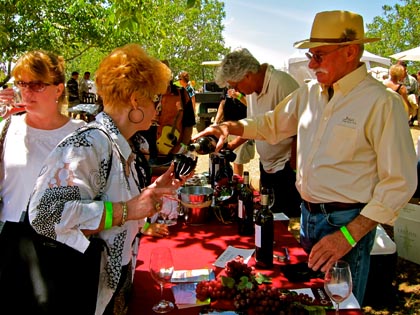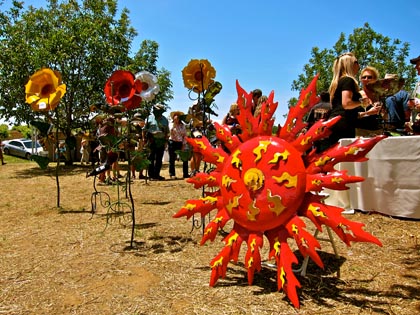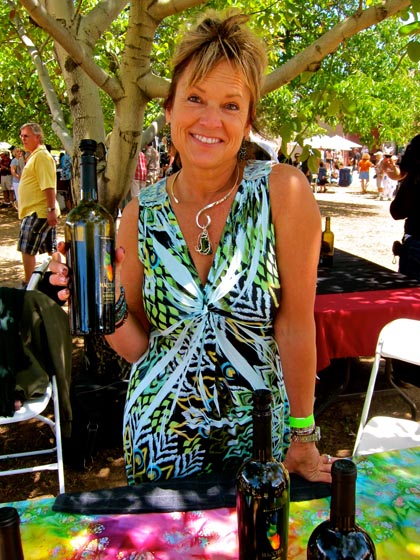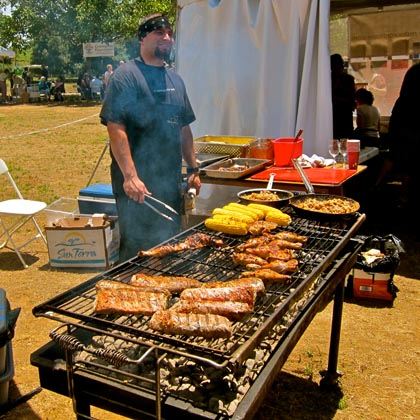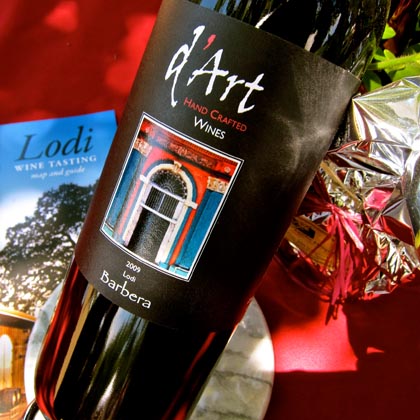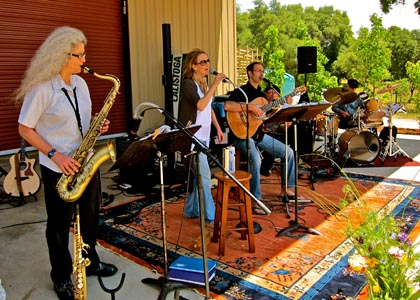Letters from Lodi
An insightful and objective look at viticulture and winemaking from the Lodi
Appellation and the growers and vintners behind these crafts. Told from the
perspective of multi-award winning wine journalist, Randy Caparoso.
No Dangerfields at Barbera fest
Steve Borra pours his Lodi grown Barbera at The Barbera Festival
The first ever Barbera Festival took place this past weekend, on June 11, in the foothills of Plymouth in Amador County. Skies were a bright baby blue, and the temperature warm but not scorching, as over 80 Barbera producers from all over California set up their tables under the walnut trees of Cooper Ranch, which has also become one of the most prestigious single vineyard designations in the Sierra Foothills AVA.
For an inaugural event, it was nothing short of successful: over 1,800 wine lovers converged at this sold out event to celebrate this grape, which makes what many a cognoscenti considers to be the pre-eminent red wine for food. Why? Because wines vinified from Barbera are rarely too heavy nor too light; almost never overly high in tannin (the phenolics derived from grape skins and seeds, giving wines their bitterness as well as potential longevity) yet just about always strong and sturdy.
Garden bling at The Barbera Festival
And – for the coup de grace – red wines made from Barbera, which generally taste of cherries (from black to Bings) or berries (mostly reds, sometimes blacks), usually have higher levels of natural acidity than other grapes; and it’s that zesty, zingy taste that many say make Barberas more food versatile than most other wines (see our previous post, Barbera, the shut-up-and-drink-it wine).
Lani Holdener & her Macchia "Delicious"
To help the Barbera lovers sort through the wines proffered for tasting, the Barbera Festival organizers (kudos to Brian Miller and Deirdre Mueller) thoughtfully passed out booklets listing each producer with room for note taking, which also gave as good an introduction to the grape as you would find anywhere: “Barbera,” we read, “originated in the Piemonte region of Northern Italy. There, Barbera is currently experiencing a renaissance of sorts.” It’s kinda cool to find out that a grape that is undergoing something of a renaissance here in the U.S. is also doing the same in the country of its origin.
Re the history of Barbera in California: “John Doyle (Cupertino Wine Company, and later Las Palmas Winery) first imported Barbera into California and produces his first Barbera vintage in 1884. In the 1890s, the Italian Swiss Colony Winery used it successfully for several of its table wines.” Old timers still remember the old Swiss Colony television and print ads, harking the “little old winemaker, me!”
“Post-prohibition,” the festival booklet goes on, “Louis Martini was the first to produce a varietal Barbera in 1954… today about 7,000 acres are planted in California, and nearly 200 California wineries produce Barbera wines.” Old timers can also fondly recall the reliably smooth, yet rock solid, Barberas by both the Martini and the Sebastiani families — keepers of the varietal’s flame during the sixties and seventies — plus this fact: in 1980 there was much more acreage of Barbera (about 20,000) in California than today. That may seem like a lot, but not in comparison to Italy, where there are still over 200,000 acres of Barbera in production.
Barberafest bbq...
As you would expect from an American Viticultural Area that has historically been the major source of grapes for what St. Amant Winery’s Stuart Spencer has called “Big Brother” wineries, for producing generic type wines by little-old-winemakers, Lodi has always been one of the largest growers of Barbera in the state.
Today, some of Lodi’s more stellar Barbera lodes – like third generation grower Ted Leventini’s coveted planting located east of Hwy. 99, and Steve Borra’s home vineyard south of Harney Lane – are approaching their fortieth leafs respectively. A lot of that goes to Big Brother, some are still packed in dry ice and trucked to wineries back East, and a smaller proportion is going into the production of ultra-premium varietal bottlings by specialists like St. Amant and Borra Vineyards, plus wineries located outside the region like Uvaggio and Cantara Cellars.
“Barbera,” Spencer has also said, “is often regarded as the Rodney Dangerfield of grape varieties – it gets no respect!” But no more, evidently, judging by the crowds of Barbera lovers who flocked to Cooper Ranch last Saturday; many of them from out-of-state, filling the local trailer parks and Mother Lode country hotels to capacity.
From our notes on the few Lodi sourced bottlings distinguishing themselves among the other Barberas — Dangerfields no more! — showcased at Cooper Ranch:
2009 d’Art, Lodi Barbera ($24) – We’ve been following this wine’s progress since its initial bottling, and right now it’s exploding from the glass with all the qualities a Barbera connoisseur adores in the grape: the intensely perfumed raspberry nose, the fleshy feel neatly cut by zesty, mouth watering acidity, and just moderate tannin bolstering a medium weight body (not too heavy, and certainly not light). In short, this baby’s stacked. A lot of credit goes to the loving detailing by winemaker/proprietor Dave Dart, and a lot to the winegrowing skill of Leland Noma, who grew this Barbera next door to Dave and Helen Dart’s ranch just south of Harney Lane. Bravo!2007 Borra, Carrú Vineyard Lodi Barbera ($25) – Grower/proprietor Steve Borra calls his Barbera Fiera del Bue Grasso, or “Fair of the Fat Ox,” in tribute to the celebration of the wines, food, and cattle that takes place each year in the family’s original home town of Carrú, in Italy’s Piemonte region. Because of natural yeast fermentation and minimalistic handling of Borra’s estate grown Barbera implemented by winemaker Markus Niggli (see our previous post, Barbera kicks butt), this wine seemed like the closest thing to the style of Barbera shown by the five Italian producers featured at the Barbera Festival: wines that were intense in the sweet bing cherry and raspberry perfumes of the grape, but also showing distinctly earth toned qualities – either faintly or strongly of loam and leather – to go along with the zesty frutiness. We can’t say the Borra was as emphatically perfumed and tart edged as those of, say, Cascina Gilli (showing their 2007 Sebri Barbera d’Asti Superiore) or Cascina Garitina (their outstanding 2007 900 NeuvSENT Barbera d’Asti Superiore), but there were distinctly loamy notes mingling with aromas of dried cherry and figs in the Borra, manifested in round, mildly tart edged, medium-full qualities in the mouth. All in all, a sepia toned, somewhat rustic rendering, in the softer style that generally distinguishes American from Italian Barberas.
Borra Barbera with Barbera soaked risotto
2008 Cantara, Lodi Barbera ($32) – Pretty classic for American style Barbera – lush strawberry/Bing cherry aromas and flavors riding on a fluid, medium-full body punctuated by zippy (but not sharp) acidity and moderate tannins – although with a real sense of depth and presence: very much showing its provenance, coming from the Leventini Vineyard, mined by other successful Barbera producers (notably St. Amant and Uvaggio).
2009 Macchia, Delicious Lodi Barbera ($18) – Of the three bottlings of Barbera produced by Macchia each year (the other two sourced from the Linsteadt and Cooper vineyards in Amador County), the Lodi grown Delicious is the softest and easiest, with ripe, fruit forward notes of black cherry and dried blueberry embedded in a round, mildly tart medium body. There is, after all, a lot to be said for gentler, straightforward styles of Barbera; especially in the context of pasta in crisp, summery primavera (think fresh peas and tagliatelle or orecchiette with fava beans and butter, as suggested by Mark Bittman in a recent New York Times piece on Pasta Primavera: the Remix).
Come to think of it, summer is definitely for food friendly red wines like well heeled, American grown Barbera!
Bossa nova & all that jazz at The Barbera Festival
